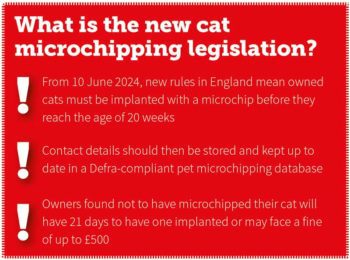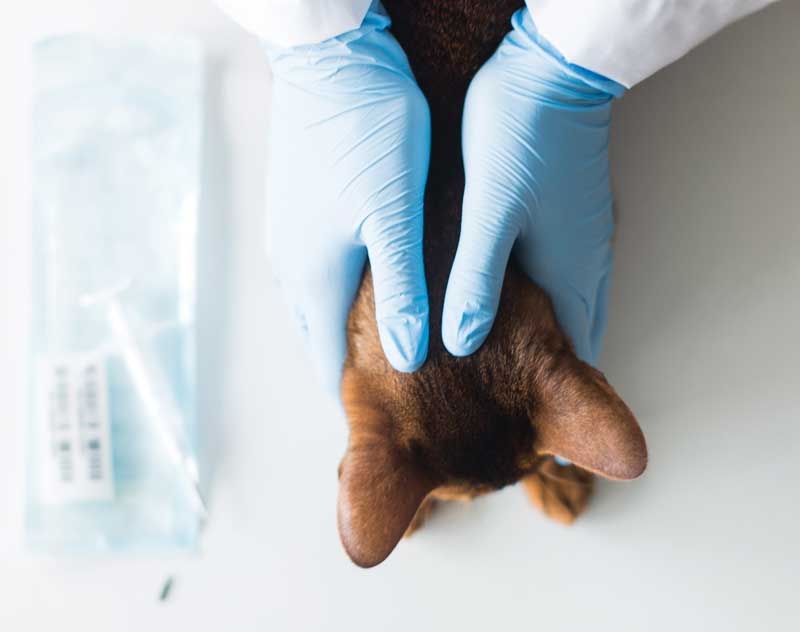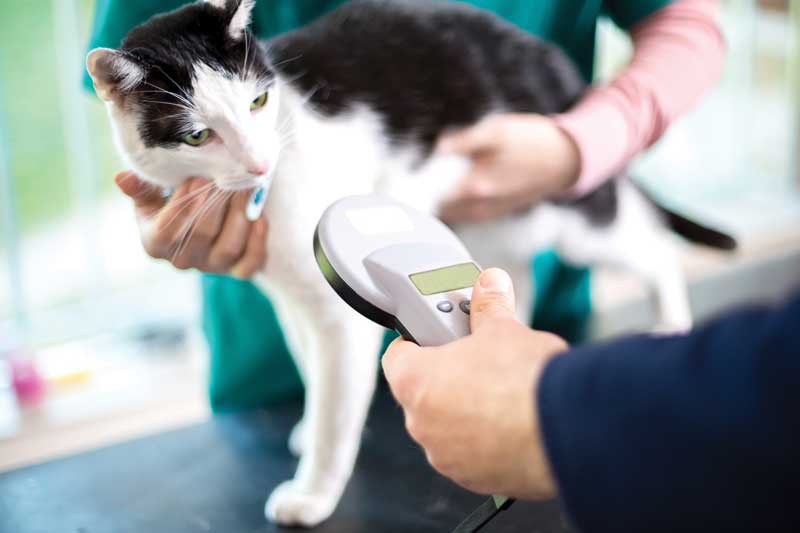It has been law that dogs in England are microchipped since 2016, and from 10 June 2024 new rules in England mean that owned cats must be implanted with a microchip before they reach the age of 20 weeks – to help reunite more families with pets that go missing.
Any owners whose cats are found not to have a chip after that date will have 21 days to have one implanted or face a potential fine of up to £500. In addition, contact details should be stored and kept up to date in a Defra-compliant pet microchipping database.
 While the veterinary profession will be well aware of the new cat microchipping legislation, the PDSA Animal Wellbeing (PAW) Report 2023 revealed 67% of all cat owners were unaware that the new cat microchipping legislation will mean all cats must be microchipped.
While the veterinary profession will be well aware of the new cat microchipping legislation, the PDSA Animal Wellbeing (PAW) Report 2023 revealed 67% of all cat owners were unaware that the new cat microchipping legislation will mean all cats must be microchipped.
The same report identified that 75% of cats have been microchipped, which, based on the PAW Report’s pet population estimates, means approximately 2.8 million cats will need to be chipped in slightly more than a year.
Of those owners whose cat was not microchipped, 19% of keepers reported it was because their cat did not go outside, 18% stated it was because it was unlikely to stray, while another 14% thought it was unnecessary.
Providing owners with relevant information is, therefore, required at every possible opportunity in practice (see panel top right).
Initially, two feline populations are involved in the cat microchipping legislation: new kittens up to 20 weeks of age; and un-microchipped older cats.
Veterinary practices can, therefore, combine neutering with microchipping appointments in kittens, and it is important to let clients (and potential clients) know about the legislation and that the practice is facilitating microchipping to meet the June 2024 deadline.

Prepare for more cats
A pre-appointment questionnaire for new feline clients is helpful to allow you to find out more about the patient prior to arrival at the practice.
If possible, the pre-appointment questionnaire should enquire about a cat’s early history – for example, where it was adopted from and if it had any pre-adoption history. It would also be helpful to find out more about any fear responses and how the cat responds to veterinary visits, if known.
Vet practices can also advise pet owners on ways to prepare a cat for a veterinary visit, and advice could focus on carrier training, handling, the importance of bringing favoured bedding and treats, and the benefit of bringing a towel for the consult table.
It is not just the personnel in the consult room who are important – a cat-friendly approach to microchipping needs to involve the entire practice team and the cat owner.
Working together can create a consent-based care approach, which is not just about the physical handling of a cat; it is about the whole consultation experience.
Veterinary practice visits should be tailored to the individual cat, to give it a sense of control and safety, and this involves understanding and responding appropriately to its emotional state.

Cat microchipping clinics in practice
Due to the increased footfall, many veterinary practices may decide to run cat microchipping clinics. These not only encourage owners to get their cats microchipped, but also enhance the vet/client bond – as well as highlighting awareness of the law and the importance of keeping contact details up to date.
By offering microchipping alongside a free health check, practices can interact with new pet owners and enable them to ask questions about their cats’ health, and build relationships going forward. It also provides practices with the opportunity to promote the benefits of wormers, flea treatments and health care plans.
Both vets and VNs can be involved in the cat microchipping clinics, depending on individual practice policy. As veterinary practices are often the main point of contact for pet owners, the BVA recommends practice staff should scan for a chip on each cat’s first presentation.
A range of ways exist for veterinary professionals to help promote microchipping clinics, including videos in the waiting room, posters throughout the practice and starting discussions during consultations.
Microchipping databases
The PAW Report 2023 revealed that 60% of veterinary professionals had experienced owners’ details not being up to date on microchip databases, with 51% stating they had seen pets who were microchipped, but not registered to any databases.
In total, 28% had seen pets registered on microchip databases not on the official Government list, and 17% had seen pets who were registered on multiple microchip databases.
In addition to the benefits the new cat microchipping legislation brings to cats and their owners, it is, therefore, vital to ensure veterinary practices are using the best microchip and database to give cats and their owners the optimum chance of being reunited in the event that they go missing. This includes the background and support of the microchip database company, which should provide a thorough, professional and extensive service. Microchipping is just the start of the pet protection journey.
At implantation, it is imperative clients are provided with clear, simple instructions on how to register the cat and that they have easy access to update details. It is advisable veterinary professionals ensure clients are aware of the route they should go through once their pet is microchipped and they should also provide information about pet protection services, the law and the consequences of not being compliant.
Due to compulsory cat microchipping, veterinary practices will see a considerable increase in cats being presented to be microchipped, which provides a golden opportunity for them to discuss other health matters – particularly if microchipping is offered alongside a free health check.
Identi has a feline microchipping webinar available on demand focusing on taking a cat-friendly approach to the microchipping appointment.
The one-hour free webinar is presented by veterinary behaviourist Sarah Heath. For more information, email contact@identichip.co.uk

New legislation promotion
- 1) Issuing emails and text alerts to clients informing them about the cat microchipping legislation, including the deadline.
- 2) Including information in the practice newsletter, as well as any blogs or articles on the vet practice website.
- 3) Promoting the new cat legislation in practice with waiting room videos, posters and leaflets at reception.
- 4) Encouraging receptionists to ask if the client knows about the cat legislation and vets and nurses can discuss microchipping during consultations, if time allows.
- 5) Including leaflets on the cat microchipping legislation in any kitten packs.
- 6) Highlighting the new cat legislation and how the vet practice is facilitating the microchipping, such as through cat microchipping clinics, social media and using any pet/client reunification stories to highlight microchipping benefits.
- 7) Contacting a journalist at the practice’s local newspaper to promote microchip clinics and the cat microchipping legislation.
- 8) National Microchipping Month, which takes place in June and provides a great opportunity to educate and promote the benefits of microchipping and the new cat microchipping legislation.

Leave a Reply